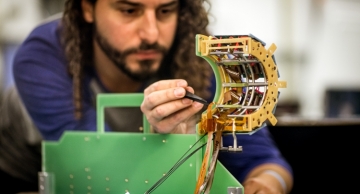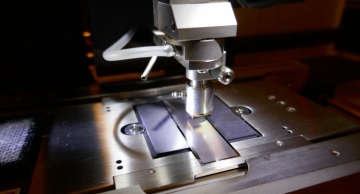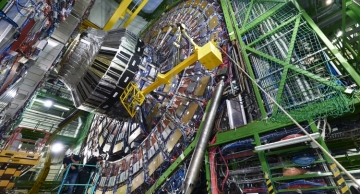The Compact Muon Solenoid (CMS) Muon System is undergoing major upgrades during Long Shutdown 2 (LS2), preparing for the High Luminosity LHC (HL-LHC). The Large Hadron Collider will be upgraded to significantly increase the luminosity (frequency of…
News
|
brcure |
Detector
The CMS magnet, one of the largest superconducting magnets in the world, with the largest stored energy, has been warmed up in April-May 2020 in order to perform an intervention on the vacuum pumping system.
The magnet is a 220-ton cylinder cooled…
|
austin |
Detector
During the early months of 2020, as the COVID-19 threat increased, CMS activity was adapted to gradually transfer responsibility to locally resident collaborators. LS2 work was accelerated in the experimental hall, so as to reach a critical LS2…
|
plujan |
Detector
When the LHC is sending billions of protons at each other millions of times per second, it’s important to know just how many of them actually are colliding, both so that the LHC can optimize its operations to produce the most collisions possible,…
|
kkaadze |
Detector
Soon after 2027, the LHC will enter the high luminosity era, known as HL-LHC, during which it is expected to deliver about 20 times more data than delivered up the end of Run 2.
In order to achieve such high luminosity, the LHC is going to use…
|
cavalari |
Detector
The CMS electromagnetic calorimeter (ECAL) measures the energy of electrons and photons produced in the LHC collisions with extreme precision. It includes, as main active element, 75848 scintillating crystals made of lead tungstate, a material that…
|
padeken |
Detector
The CMS detector is going through multiple maintenance works during the LHC Long Shutdown 2 (LS2), the first year of which is approaching its end. The beginning of 2019 saw the CMS Tracker Pixel detector extraction that is now stored in a clean room…
|
dittmann |
Detector
With the connection of the final cable on October 4, CMS completed the installation of new on-detector electronics for the Hadron Calorimeter (HCAL) barrel detector.
Following a series of upgrades to the electronics of various HCAL…
|
estarlin |
Detector
On July 25th, 2019, the very first GEM superchambers were installed into the CMS YE- endcap as part of the newest CMS muon subsystem, GE1/1. And while this was a fantastic accomplishment worth celebrating, it was only the beginning of the story.…
|
barneyd |
Detector
The high-granularity calorimeter (HGCAL) is a major upgrade of CMS, and is necessary to maintain excellent calorimetric performance in the endcaps during HL-LHC operations.
HGCAL is one of the most ambitious detector projects undertaken, due to the…
|
estarlin |
Detector
The CMS Gas Electron Multiplier (GEM) subsystem will form an extra layer of detectors, along with the Cathode Strip Chambers (CSC) layers, closest to the beam. The GEM's ability to cope with a very high particle rate will greatly improve…
|
vlimant |
Detector
Managing the amount of data from the Large Hadron Collider (LHC) collisions is a major challenge for CMS physicists. The detector produces more than 500 terabytes of data per second. Even after sophisticated real-time processing and filtering of the…












